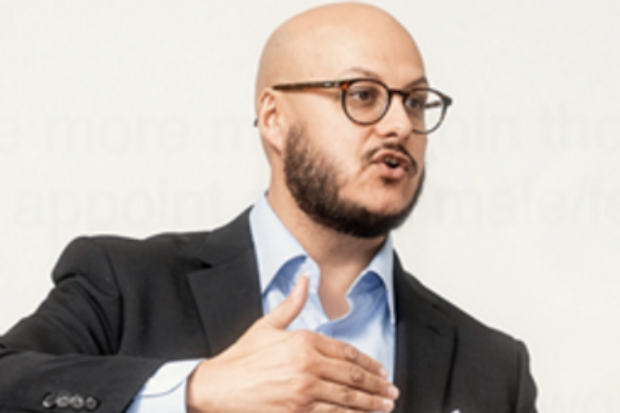This is the second blog post that I am introducing as part of the internal gender consultation we launched for International Women’s Day 2019.
As gender champion, I am fortunate to be able to work every day with individuals who are role-modelling inclusive behaviours and taking action for gender equality. These blog posts showcase just a few of those brilliant leaders.
We would like to encourage all civil servants to read our gender consultation document and have your say in shaping our priorities going forward. The consultation report can be found on your departmental intranet.
This blog post is from Jason Ghaboos, who spent a year on secondment at Cambridge University researching the power of engaging men in gender equality. Read his reflections below.
Melanie Dawes, Civil Service Gender Champion

On International Women’s Day, having presented at an event at the Health & Safety Executive, I listened to the other speakers and contributions from around the auditorium; reflecting on the points being made and my own experiences over the past 12 months.
This past year, I have been on secondment to the University of Cambridge, Murray Edwards College (New Hall), as Bye-Fellow, focusing on workplace culture and gender inclusivity and leading their Collaborating with Men research.
The research has helped shine a light on the significant impact daily behaviours/experiences (micro-aggressions) can have on all staff contributing to inhospitable workplace cultures that work against gender inclusivity, inhibiting optimal staff performance and wasting talent.
Gendered judgements, made by men and women, impact the experience of the workplace for both men and women, often having a greater impact on women’s progress to leadership positions. It is not helpful to think of these as ‘women’s issues’, because they affect us all, as do the benefits when overcoming them.
The key insight from our research is that to deliver significant, successful and sustained improvements in gender inclusivity and workplace culture for all staff, women and men need to work together to tackle gendered assumptions, at an individual and organisational level.
I have had the opportunity to work closely with organisations across all sectors to help them gain a detailed understanding of the perceptions and experiences of daily biases that occur in their organisations; identifying bespoke interventions and strategies for addressing concerns and improving culture.
We recently published our findings and our work has featured in Forbes, the Financial Times and other outlets.
Across the UK there are many fantastic examples of private sector organisations working tirelessly to improve culture and the everyday experiences of their staff. While the work is far from complete in the Civil Service, I have frequently praised the energy, passion and determination of civil servants – at all levels – to improve the working experiences for all staff.
In many ways, I think the Civil Service is an exemplar in this regard.
On my return to the Home Office (HO), I am excited to be co-chair the Gender Equality Network (GEN) alongside Kerry O’Dea. This will be the first time the HO has had a male lead or co-leads of its gender network.
Kerry and I are committed to embedding gender equality in who we are and what we do. Focusing on talent, balanced representation, workplace culture and intersectionality to continue to make the experiences of women and men as positive as possible within their careers. Of course, gender is not binary, and our focus in GEN is to work collaboratively with the staff networks, the D&I and HR teams, and external experts, to deliver interventions that improve the experiences of all staff.
I was pleased to read the Cabinet Office’s #BalanceForBetter: an internal consultation document on gender diversity in the Civil Service. It reflected my experience that there is lots of positive work happening in gender inclusivity, while acknowledging that there is still some way to go. This document is all about collaboration. It is actively seeking the views of where next to focus efforts, as well as celebrating best practice from across departments.
Over the last year, the most frequent challenge I have encountered: why focus on gender? There is a strong belief in some quarters that the gender issue has been solved and the focus should be on other challenges. In the Civil Service, 54% of staff are women, which is a positive. Yet the representation at senior levels is not as equally reflected. Numbers are important, but the experiences of civil servants are too. Diversity is one hurdle, inclusion is another and the race is not yet over.
We want to hear from all civil servants whether we are focusing on the right areas in pursuit of gender equality.
You can find the gender consultation report on your departmental intranets, and email your ideas to inclusion@cabinetoffice.gov.uk.
The consultation period will close on 26 April 2019.

2 comments
Comment by Sharron Parry posted on
I'm on the Gender Network group for Liverpool and t he Committee for the Liverpool Region Women's Group and Lead the Men's group but I'm struggling to get men to engage in any awareness sessions. The Women's group is thriving and grown so much in the 4 years its been in existence. Any idea's how I could approach the men in our region to work with them to provide what they need in learning, development and healt? Any advice would be appreciated.
Comment by Mark Mavin posted on
Continually striving for equality and diversity in the workplace is the only right and proper thing to do and #BalanceforBetter is an excellent hashtag. I do wonder though why a workforce of 54% women is a 'positive' thing - it is hardly gender balance and neither is only 43% of Executive Officer grade being male or only 43% of AA/AO grades being male.
Although it is right we look at where women are under-represented in the more senior roles we should also, at the same time, look at all areas of under-representation, then we really would be striving for gender equality